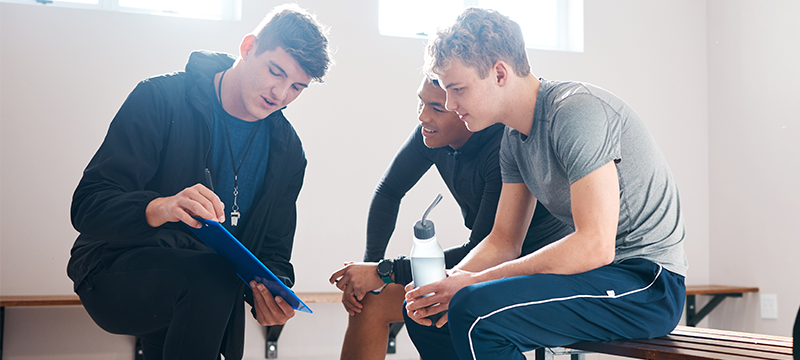Register now and start:
- Accessing PAR Training
- Shopping PAR products & tools
- Using online assessments with PARiConnect


Personality affects virtually every aspect of a person and how they act in various settings, both personal and professional. So, why do we often overlook the value of personality insights when it comes to professional athletes? Sport psychologists use psychological knowledge and skills—including understanding the importance and impacts of personality—to assist athletes, coaches, and other sports participants with:
Equipped with the right tools, sport psychologists have the opportunity to enhance team dynamics in ways that benefit players, coaches, and the team as a whole. That’s where psychological assessment tools come into play, as tests such as the NEO Inventories Normative Update provide a comprehensive view into an individual’s unique personality.
In this article, we will discuss how sport psychologists can use the NEO Inventories to evaluate prospects and recruits to determine the best fit for the given team dynamic, as well as the various benefits of these assessment tools.
Several factors are taken into account when a prospective athlete is being considered for a team. While physical aspects like a player’s athletic ability and injury history are important to these considerations, so are mental factors such as:
Make-or-break components like these are dependent largely on a player’s personality. Recent studies have pointed at a multifaceted relationship between personality traits and sports performance (Shuai et al., 2023), with compelling evidence being offered about the five major personality traits (Neuroticism, Extraversion, Openness to Experience, Agreeableness, and Conscientiousness) and their roles in athletics.
Some theories—such as the “gravity hypothesis”—question whether people with certain personality traits are more likely to participate in sports to begin with, as many studies show that team sports participants tend to rate highly on Extraversion (Eagleton et al., 2007). With this theory in mind, it’s important to note that even minor differences in personality between individuals can have profound implications. This means that having a clear look at every player or prospect’s personality can have an immense influence on team dynamics and success.
Personality’s significance on sports participation and performance is considered to be two-fold, as it directly or indirectly affects:
After all, only a small proportion of an athlete’s time is taken up by playing against another team. This makes the time they spend off the field or court equally as important—if not more so—than the time they spend on it, as their habits and general traits can be indicative of how they will perform when playing. A review by Allen et al. (2013) highlights how personality shapes organized sports and team dynamics, as personality traits have predictive power that can be applied in sports settings.
Considering the five central personality traits can help to improve team dynamics by understanding where players may clash, where they may naturally excel, how they can work together more successfully. For example, individuals that are more extroverted may perform better in team sports like baseball, yet players with naturally introverted personalities (like Joe DiMaggio, a well-known example of such a case) can adopt the required traits to succeed.
Sport psychology is key to enhancing team dynamics, as is using the right psychological assessment tools to do so. The NEO Inventories Normative Update are concise measures of the five domains of personality and the most important traits that define each domain. These comprehensive assessment tools have over three decades of valid and reliable use, with a recent update to include a new normative sample representative of the current U.S. population, easier purchasing options, and condensed forms that simplify administration and scoring.
But what exactly makes the NEO Inventories Normative Update worth using for sport psychologists? The answer to that lies in the versatility of the instruments themselves as well as the breadth of the insights that they provide. Professionals across a variety of industries have used these assessment tools to benefit the clients and businesses they work with, including sport psychologists.
There are also different versions of the NEO Inventories, allowing sport psychologists to choose the one that best fits their needs. From there, the scores and data provided can be used to gain an in-depth profile of a prospect or recruit’s individual personality profile. In the same way that an HR professional might use these insights when evaluating candidates for a job opening, sport psychologists can use them to predict how a prospect or recruit might perform and interact with the rest of the team. For example, baseball players must be quick thinkers, the NEO Inventories can help you identify players who can think on their feet.
This can also apply to existing team dynamics, as acquiring insights about each player’s personality can help with streamlining potential issues that may come up as well as with predicting how a potential new member might interact with the rest of the team.
Ready to see for yourself how the NEO Inventories Normative Update can help in your work as a sport psychologist? With these assessment tools, you’re able to evaluate new recruits and know if they are in the right headspace to join and grow with your team. Discover the possibilities for your team with the NEO Inventories from PAR.
Sources: Shuai Y, Wang S, Liu X, Kueh YC and Kuan G (2023) The influence of the five-factor model of personality on performance in competitive sports: a review. Front. Psychol. 14:1284378. doi: 10.3389/fpsyg.2023.1284378
Sutin, A. R., Stephan, Y., Luchetti, M., Artese, A., Oshio, A., and Terracciano, A. (2016). The five-factor model of personality and physical inactivity: a meta-analysis of 16 samples. J. Res. Pers. 63, 22–28. doi: 10.1016/j.jrp.2016.05.001